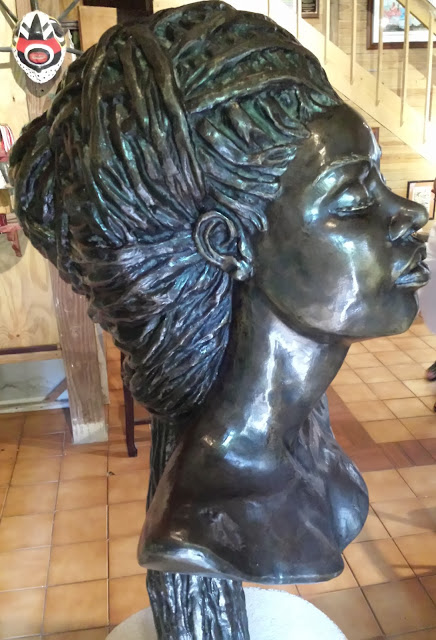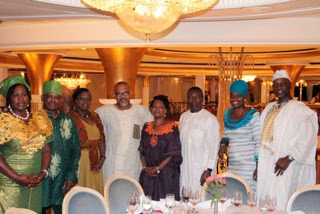Carving with hair symbolic of memory
Back in San, Juan, the Coral Princess, dubbing itself “a small boutique hotel” adequately met our needs for the remaining two nights. I loved its palms, lavishly cascading in the yard, the tiny two-person pool, the lemony and earthy colours they’d used to give the impression of hominess and warmth. I appreciated the little Jacuzzi on the roof where I had a moment alone with my thoughts and another chance to feel the sun enriching me with the Vitamin D I lacked. Something in me had changed. I felt more alive. I had made the resolution that this trip was blessed. I had felt the presence of our ancestors throughout the journey on the islands. An inner voice was telling me that “there was more” that the trip was not over. Yes, we were back on land, in Puerto Rico, we didn’t have the pressure of returning to the ship before it potentially sailed without us, but the experiences so far had not ended. There was some kind of secret joy inside of me which I couldn’t quite share with the others. But it was agreed that we would do our ritual of libation in Puerto Rico the following morning, and I was very much looking forward to it.
There was a festive vibes on the streets of San Juan because we happened to be there on the last Sunday of the month (of November), the end of a week-long Jazz festival. We walked through the buzzing main street heading towards a supermarket to buy the gifts with which to honour the ancestors at the sea. We also sought last minute gifts, local music (some classic salsa) on our way. And we found our music – live. Bomba is a drum that plays to a dancer’s movements. There are two drums; one keeps its rhythm whilst the other precisely matches the dancer. Two elders, who had recently marked 100 years of the Bomba tradition in their family happened to be on the street and gave us a sampling of the sound. A sister took to the challenge and danced since it was a compulsion of spirit she couldn’t resist. It reminded me of a similar scene of drumming in Guyana on emancipation day.
We were up and out of the hotel by 7.30 in the morning. The beach was minutes away. Gathered in our circle of eight, we nested our gifts – fruits, sweet bread and a little bouquet of flowers on the sand. We spoke our tribute to our ancestors. We told them we remembered and will honour their humanity; we remembered their great capacity for love even when they were being cast as human cattle; they had love for each other and yet for us – even when we did not acknowledge them the way others devoutly acknowledged their ancestors. We could not be on these islands without honouring them. We remembered the ancient ones who never knew the horror of enslavement, who enriched the world with true civilisation (with art, religions of Truth, holistic education, healing traditions, science and so forth). But here on the island we particularly honoured those who endured that bitter fate and fought for their freedom and ours. We told them we would remember every one of them from all the islands – not just those we had visited – so yes we remembered One Titty Lokhay of St Maarten. We remembered our immediate and familial ancestors. We called those names we knew but in our hearts acknowledged the good ones we didn’t know but whose spirit lived with us, guiding and protecting us always.
We sang “By the rivers of Babylon” and other tunes to inspire them to manifest. We poured bottled water on the sand, white rum too. We sipped some of the rum and puffed a few smokes from a cigar - calling them. We lit incense and soon a splash of sunshine radiated on the offering, within a moment delicate drops of rain graced our expectant faces and we recognised the blessing. And so we would know and believe they were with us the most delightful rainbow arched before us like a magical arm extending toward our hearts. We vibrated in the moment, laughed and cried and marvelled, said many more thank yous to them, waved toward the sky and felt humbled at being in the powerful presence of spirit.
And this before we met Samuel Lind.
We had met our tour guide on the ship. It was no coincidence. On one of the “dress up” formal nights we wore traditional (African) clothing. Carlos asked if he could take a photo with us because he loved our dress. He was from Puerto Rico and had his own taxi service. We agreed that we would hire him on our return, since we hadn’t seen the island, and longed to visit Old San Juan.
When we called him he insisted we go to Loiza, where the most concentration of Africans lived on the island. It was a Monday morning, the town was too quiet since most people would be at work. He had hoped to take us to the Ayala family who maintain African traditions, particularly the craft of mask making on the island. We sort of wilted when we saw the house was locked up.
Across the road we had noticed a sign for – “Estudio del arte naturaleza y cultura de Samuel Lind.” A member of the Ayala family, sensing our disappointment that his family’s “museum” was closed said we should instead visit the studio.
Did that rainbow on the beach disappear? Or was it some kind of arrow shooting through time and space to lead us precisely where we needed to be?
Our first greeting into the studio was a wood carving of a sister, her long locks Samuel told us symbolised memory. Her locks were gathered into an upright pole on which her head and shoulders rested in a powerful display of conceptual symmetry. There was mystery and light emanating from every corner of the studio. Every painting and sculpture was infused with the magnificence of spirit. It seemed we were gliding through the studio, floating in the haze of an intersection between the spiritual and physical world.
This and the above image are of Bomba Dancers
Osaniyin, orisha of herbs
Samuel Lind seemed nervous as he described his creations and what had inspired him to do each piece. At first I wondered why, thinking that despite his artistic brilliance, he didn’t believe in himself. But the apparent nervousness was also excitement; he said he was glad to see us – as though our meeting was a long time coming and overdued. That other thing we were promised – that un-ended experience the spirit intuited to me the day before was now tingling my bones.
Downstairs, the studio tailed off into two smaller rooms, both greeting us with more resplendent carvings and powerful images. Samuel, born in Loiza, had created a space for the manifestation of ancestral spirits which were enshrined in the pieces. Not only ancestors but orishas like Osaniyin, the god of herbs and healing who was present in several images. It seemed natural that Osaniyin was his muse; but for me the relationship was more than this. Muse and artist were the combined force of creative expression. Samuel told us that we would recognise nature (Osaniyin) everywhere in his art. He showed us a “mock up” of an enormous carving of the Orisha that is resident in a Park on the Island.
This beautiful space colouring our senses with something enchanting was also where Samuel lived with his wife Nina. The studio was slightly off radar, in this seemingly hidden part of Puerto Rico, where Africans were marginalised. Samuel had faithfully brought life to his home town by capturing the everyday activities and cultural experiences of his people. The Bomba Dance, with which we had been treated the previous night, was featured in a number of the paintings and prints. Masks and masquerading also featured in his art; many of these images embodied the cultural mestizo of Puerto Rico. In some of the festival prints, Orishas like Legba were represented alongside Spanish conquistadors, with a Bomba drum acting as the base or root of the image. Each of these inflections was part of Samuel’s cultural experiences and therefore coalesced in his work.
Festival Print
Samuel and the proud lady in blue
Of course the space could not be complete without representations of the Taino. Bold, stunning faces, mainly of women embodying the indigenous spirits stared back at us as proudly as each African portrait. There are patchy tales about the town being ruled by a female “cacique” (a title given to indigenous chief or ruler) prior to Spanish conquest, from where it’s possible the name was derived. Puerto Rico, particularly Loiza where enslaved Africans were shipped by the Spanish has a history of “rebellion” as much as there was on any of the Caribbean islands. Forced to live together, naturally there would prevail a cultural mixing between the Taino and Africans, but also combined forces of resistance. Samuel captures this by ascribing pride to every piece. As with the African carvings and paintings of Africans, no Taino woman or child looked forlorn or sombre but exuded pride and power –light majestically radiating from them. The sculptures and paintings resonated the deep textures of culture and history – in the clothes/costumes, dances and symbolic gestures.
When he introduced us to the lady wearing a blue dress, it was impossible to resist the energy she possessed. Carlos, our guide was struck for the first time in his life by “goosepimples” – he kept asking us what the strange feeling coursing through his body meant. I can’t recall if anyone answered him because we were also feeling the energy building in us. Some of us simply embraced the feeling and cried. Others kept theirs in the confines of their heart, perhaps to release in privacy.
In a private back room we were privileged to see the wall size impression of “Terra Mujer” (mother earth). From that quieter place she could inspire the artist to produce many more magnificent pieces. The earth mother – the force of creation was powerfully represented by her son Samuel. The orishas and the ancestors anchored him and empowered his creative abilities. He told us that prior to our visit he was feeling unwell but as we embraced him for a last goodbye he said his ancestors had blessed him that day. But it was we who had been blessed all the way by the wonderful grace and love of our ancestors. I saw in Samuel an incarnated brother, I saw in the group with whom I travelled the reunion of family, which was vibrated in the exchange of our deep embrace. Hidden in the marshes of little Loiza tucked away in Puerto Rico, the spirit of ancestors remain. It was an honour to embrace them in that ritual of creativity so wonderfully expressed in the art of Samuel Lind.
Terra Mujer
Shout out









.jpg)











I too cried when I walked thru his studio, specially when I saw Tierra Mujer. His generous heart gave me a Tierra Mujer lithograph as a born day present. Afterwards, we went to eat and dance bomba y plena at a local establishment; Nina it's a great dancer! Hope to visit soon.
ReplyDeleteThat sounds great. Thanks for sharing. We didn't get to meet Nina but have since communicated on email - it would be wonderful to see her dance. And definitely looking forward to one day going back.
Delete